For the past decade, Roofing Contractor has gauged the status of the North American roofing industry by turning to you, our readers, to help identify the issues and trends impacting the overall business climate that drives some contractors to succeed in both residential and commercial sectors.
Contents
That mission continues moving into the first quarter of 2018 with our annual State of the Industry survey and report. With help from industry leader GAF and the data-collection experts at BNP Market Research — the research wing of BNP Media, RC’s parent company — the following report provides a glimpse of the challenges and successes of the past year. It also puts into perspective the general optimism felt industrywide as the economy shows strong signs of recovery, and much anticipated changes to regulations and taxes begin to take shape under the new presidential administration.
Specifically, the survey was designed to identify: sales volumes for the past year; projected sales for 2018 and the next three years; trends among different roofing product categories; improvements in technology; and key challenges facing the industry as the economic recovery continues. In addition, we asked about the unprecedented volatility of the 2017 storm season, safety and OSHA inspections, professional certification efforts, and related workforce issues.
The annual survey, now in its 10th year, again targeted residential and commercial roofing contractors from around the United States and circulated between Oct. 26 and Nov. 9, 2017.

Looking Ahead: Propelling the Roofing Industry Forward in 2018
Jim Schnepper
Our industry is changing and 2017 was an indication of just how important it is to embrace that change in order to succeed. Let’s reflect back on what happened in 2017 and look ahead to 2018.
From a macroeconomic perspective, the U.S. economy strengthened in 2017. The unemployment rate was at a historic low, modest interest rates drove home purchasing, and consumer confidence was on the rise.
For roofing, 2017 was a year of... (Read more...)
For the sake of full disclosure, RC randomly provided 10 $50 gift cards to respondents that completed the survey in its entirety.
Respondents included roofing professionals that subscribe to RC, and a sampling of contractor members from the Midwest Roofing Contractors Association and the Western States Roofing Contractors Association.
As in previous State of the Industry reports, the majority of survey respondents identified themselves as corporate leaders or members of executive management in commercial or residential roofing companies. The vast majority (68 percent residential, 51 percent commercial) indicated they have purchasing power. Their average age was between 50 and 51, and the majority had between 11 and 40 years of experience in the industry.
Companies that derived at least 70 percent of their business revenue from residential work were classified as residential, and the same standard applied to commercial roofing contractors that responded to the survey.
Among residential roofing contractors, the majority of respondents indicated they generated between $250,000 to $5 million, and had less than 10 employees. In the commercial sector, the majority of contractors said they have between 10 and 50 employees that generated between $2-$10 million, the report showed.
Roofing Sales Volumes to Increase in 2017
While many in the roofing industry may lament the pace of economic growth and deregulation expected in 2017, none appear to be complaining about sales. Seventy percent or more of respondents said they anticipated sales volumes to increase in 2017, again in 2018, and over the next three years. That’s a slight increase over RC’s 2017 survey, and third consecutive year of an uptick.
Commercial roofing contractors were especially bullish with their sales outlook, with 77 percent anticipating sales to increase in the year ahead, and 86 percent expecting increases over the next three years.
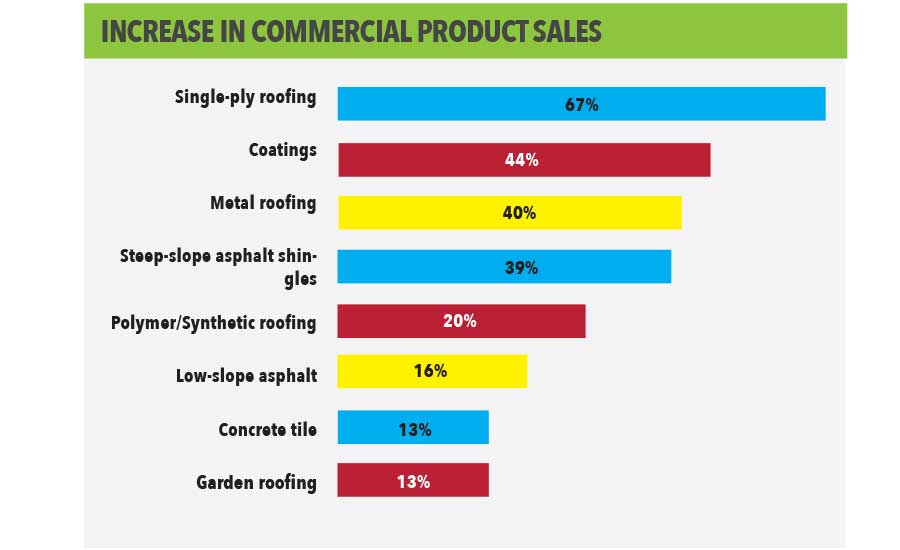
The survey data confirms prior indications that the roofing industry is strong, vibrant and full of promise in many markets across the country. That confidence in the future is also driving deals, particularly on the commercial roofing front. RC’s 2017 Commercial Roofing Report — published in December 2017 and based on survey data specifically from commercial roofing contractors across the country — showed 65 percent of respondents expect this year to look as good or even better than 2017. More than three-quarters (76 percent) indicated they expected sales to grow through 2020.
Both surveys showed the overwhelming majority of commercial contractors are involved with single-ply roofing, followed by metal and low-slope asphalt. Roof coatings maintained the fourth position, although with a decreased product involvement rate (56 percent) from last year’s survey (63 percent).
Who Took Roofing Contractor’s 2018 Annual State of the Industry Survey?
Roofing Contractor and BNP Market Research again reached out to roofing professionals across the country to collect their perspectives on the residential and commercial markets in 2017, and gauge their prospects for the year ahead. Here’s a closer look at just who responded to the annual RC State of the Industry survey, sponsored by GAF.
That said, interest in coatings is hardly waning, according to the experts and further study of the data. While single-ply dominates the commercial market by accounting for more than half of overall sales revenue (57 percent), coatings accounts for just 6 percent. However, when asked about which product sales contractors expected to increase during last year, 44 percent chose coatings, second only to single-ply (67 percent), and ahead of both metal (40 percent) and steep-slope asphalt (39 percent). It’s at least the fourth straight year that anticipated coatings sales outpaced both metal and steep-slope shingles, according to survey data.
More than half of those respondents said they expected coatings sales to increase in 2018.
Doug Kramer, president of Lapolla Industries since 2005, said the increased emphasis on coatings is not an anomaly or a fluke.
“Roof coatings remain a lower cost solution to extending the longevity of almost any roofing system,” Kramer explained. “Coatings are also renewable, meaning you may continue to re-coat the roof, and also have inherent performance value in their reflectivity and thermal emissivity abilities, which can only help the overall performance of the building.”
Jack Henderson, president of DCI Products, said he’d like to see more definitive research on the benefits of coatings in certain markets. But the cost savings mean coatings are likely here to stay.
“I believe more studies are needed to reflect the energy efficiency of ‘white’ coatings in the cold states verses dark coatings for better heating efficiency,” he explained. “Sometimes the bandwagon gets carried away with false information, so the jury is still out regarding the efficiency in the northern states. But roof coatings, in general I believe, are great for roof protection on low slopes. I believe the growth will continue.”
The performance of metal roofs also seems to be having an impact on contractors and facility owners. The expected increase in metal roofing sales in 2018 surged to 60 percent, the highest amount recorded by RC survey respondents since 2012.
Other notable figures from the survey on commercial roofing include slight upticks in the use of polymer/synthetic roofing and SPF spray foam from last year, and the continued stability of concrete tile, slate and garden roofing — all hovering between 21 and 23 percent.
Rick Duncan, technical director of the Spray Polyurethane Foam Alliance, said the organization projects the growth in SPF use to continue due to the rebounding economy.
“We believe this is likely a result of the recent economic recovery that has enabled both commercial building owners, as well as residential homeowners, to spend more on long due roofing maintenance and repairs,” he explained. “The use of roof coatings is a big part of this repair and restoration work.”
Despite concerns over costs due to proposed tariffs and long-term uncertainty over government subsidies, more commercial roofing contractors (17 percent) indicated they installed solar products in 2017. The number of contractors expecting solar sales to increase in the next year climbed to 44 percent, ahead of both low-slope asphalt and garden roofing.
Residential Roofing Revenue Increases Anticipated
The 2017 survey showed confidence among residential roofers was less demonstrative than their colleagues in commercial roofing. Yet the optimism remained measurably strong, with 77 percent indicating sales over the next three years would be prosperous.
The overwhelming majority of survey respondents in the residential roofing category (72 percent) said they anticipate revenue to increase specifically in 2018. While interest rates are on the rise, they’re still relatively-low enough to keep housing estimates from declining sharply, which is helping fuel continued optimism.

Strong economic performances in other industries also appear to confirm that there’s reasons for roofers to feel optimistic. On the residential side, U.S. homebuilders are reportedly sensing the positive economic momentum. The National Association of Home Builders reported its builder-sentiment index rose to 74 last December — the highest since July 1999. The index is measured using three primary components — a developer’s outlook for single-home sales; the perception of sales over the next six months; and a measured view of the traffic created by current prospective buyers.

Tax Bill Will Ignite the U.S. Economy
Craig Brightup
On Dec. 22, 2017, President Donald Trump signed into law the Tax Cuts and Jobs Act (H.R. 1). As a result, America now has a revamped tax code for the first time since 1986... (Read more...)
At the time of publication, Keith Lowe, vice president of sales for IKO, said he was still awaiting final annual numbers but anticipated last year was stronger than 2016 primarily due to storm activity, and demand in the reroof and remodeling categories.
“The housing and remodeling market continued its steady recovery, resulting in higher consumer confidence,” Lowe said. “This has led to more consumer dollars spent on reroof, and we anticipate this being the trend for the foreseeable future.”
The survey showed that steep-slope asphalt sales still account for more than half of all residential sales revenue (55 percent). No other product accounted for more than the 11 percent achieved by metal roofing, and coatings appeared toward the bottom of the list at just 2 percent.
However, two-thirds of respondents indicated an increase of coatings sales in residential roofing last year, closely behind only metal roofing.
When asked which product sales they’d expect to increase in 2018, more than half of residential roofing contractors said steep-slope asphalt (60 percent) and metal (56 percent). Not far behind was coatings (48 percent), a full 18 percent higher than results from last year. The significant jump in interest and potential sales are proving that coatings aren’t just having an impact on the commercial side of the roofing industry.
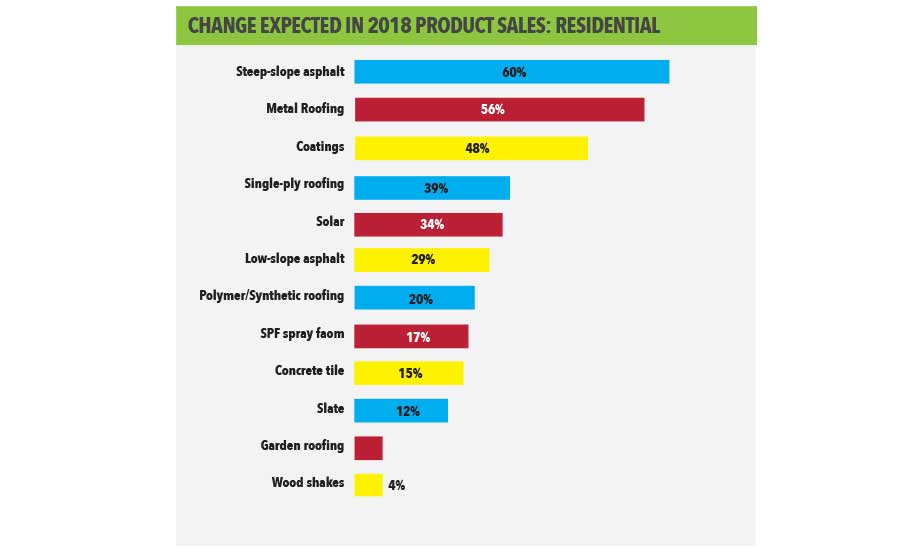
“I see it as a move to better longevity of a roof system as well as energy efficiency on the whole,” said Henderson.
Ralph Vasami, acting executive vice president of the Asphalt Roofing Manufacturers Association, said growth in residential coatings is logical given that the majority of homeowners are budget conscious and that they can meet surface-reflection requirements in some areas. Yet, they need to approach with caution.
“It’s imperative that homeowners and building owners ensure that any roof coating they wish to apply is approved by the roofing shingle or membrane manufacturer,” he stated.
Roofing Products and Roofing Technology
When it comes to commercial single-ply roofing products, TPO continues to lead at 52 percent, followed by EPDM (30 percent) and PVC (18 percent), data showed.
While he agrees with survey respondents that indicated EPDM and TPO still rule the market, Mike DuCharme, vice president of marketing for Carlisle Construction Materials, said the growth in polyiso — thanks largely to the recent changes in ASHRE codes — has been noticeably impressive. Carlisle experienced more product sales of that per square foot than others last year.
“It’s really been a solid year, and we’re starting to see strong growth in multiple product categories,” he said. “Our product sales are growing well organically and nailing down tax reform will lead to even stronger results. We anticipate seeing a nice lift.”
Metal roofing’s popularity in the residential market appeared to be affirmed by the survey. The Metal Roofing Alliance announced that 2016 figures (the last year available) showed the market share for metal residential roofing increased from 11 to 14 percent in just 12 months. Residential roofers indicated they’re feeling the demand, with 69 percent saying metal roofing sales increased in 2017.
The survey also asked roofing contractors which software programs and new technology they’re infusing into their business models. Respondents indicated that they most commonly use aerial measurement and estimating software, and a significantly larger number of commercial roofers are using drones. The data shows 33 percent of commercial contractors use drones and just 20 percent of residential roofers do the same. The only category where residential roofers slightly outpaced commercial contractors was in use of cloud computing (31 percent to 29 percent for commercial.)
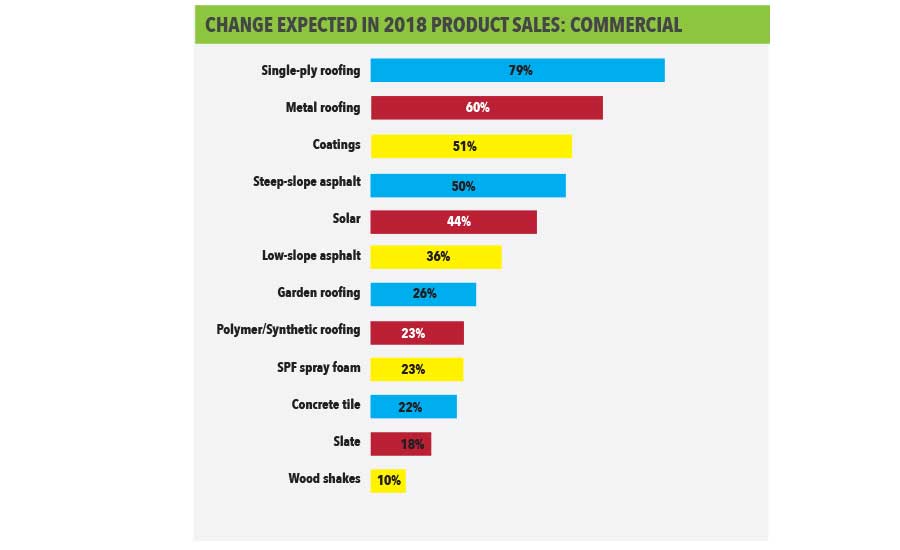
That said, only one-third of survey respondents said they used drones, and in most cases (between 74 and 79 percent), they were needed for marketing photos and videos. Roughly 58 of residential contractors said they used drones for inspections, and just 16 percent used them for measuring. On the commercial side, roughly the same amount of roofers use drones for before-and-after project shots and videos (76 percent), but a noticeably larger number of commercial roofers use drones for inspections (71percent), the data showed.
Effect of Major Storms on the Roofing Industry
The National Oceanic and Atmospheric Administration reported 21,672 storms across the country in 2017. The severity ranged, but there’s little doubt the year will be remembered for the unprecedented stretch between late August and mid-September when four major hurricanes struck the U.S. and Caribbean. Death tolls surged into the hundreds, and damages soared into the hundreds of billions of dollars.
Few companies experienced the storms quite like Houston-based Icynene-Lapolla. While accustomed to the regional threat of hurricanes and severe tropical weather, few companies were equipped and prepared for the magnitude of Hurricane Harvey and the devastating flooding that followed.
Kramer said that through planning and technology they were able to safely get through the storm with little to no disruption of material supply to customers. They did so by functioning remotely through the cloud and shipping materials from the unaffected areas of the country.
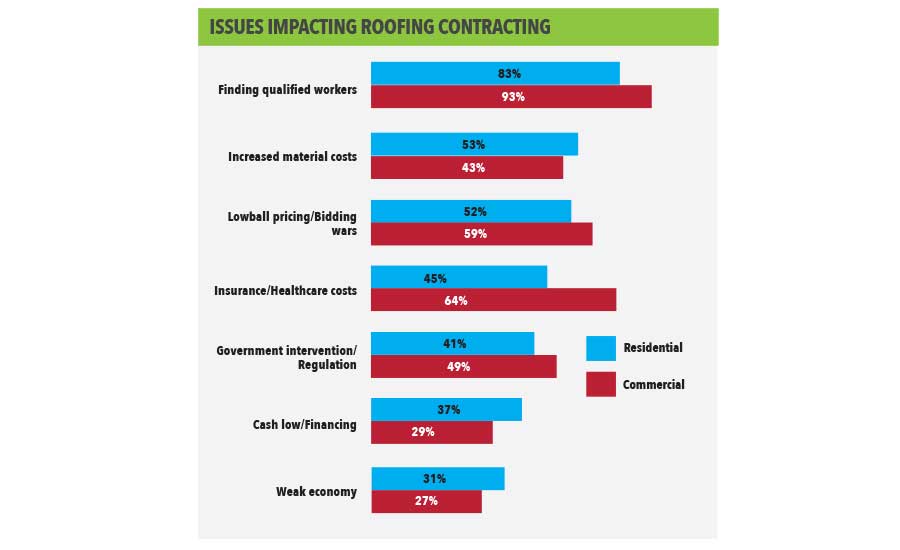
“We had a plan in place to help ensure our ability to navigate a crisis of that magnitude and to ensure lack of disruption of supply to our customers, as well as the safety of our employees,” Kramer said.
Roof demand across all sectors increased as a result. Duncan said that’s good for SPF, particularly in areas typically at risk of tumultuous tropical storms.
“Spray foam roofing is not only water resistant and insulating, but it is proven to be effective at resisting the effects of wind uplift,” he explained. “We believe that the use of closed-cell spray foam insulation will also increase in flood prone areas because of its water resistance.”
Rich Thomas, marketing product manager for Boral Roofing, said the company has seen significant pressure on demand in the Southeast and Texas markets because of storm damage and increased home building.
The demand for spray foam could also increase out West — which was ravaged by large wildfires — because it can help mitigate fires from spreading between homes, he said.
Despite the impact of the storms to the heart of the SPF industry in southern Texas and Louisiana, industry experts said any impact on supply chains were short lived.
Henderson said he doesn’t believe the storms will create distribution problems in the year ahead, and said roofers and others in the industry can actually benefit positively if they’re looking at the situation from a unique viewpoint.
“It’s an opportunity from a business standpoint,” he said. “These natural disasters create opportunities because they are so crippling at the local level. The infrastructure and buildings within need to be addressed in an engineering mindset. There are so many areas of improvement that exist in the regions that are vulnerable.”
Corporate Mergers and Acquisitions
The roofing industry again proved to be fertile ground for corporate mergers and acquisitions in 2017. Among several headline-grabbing announcements to follow-up 2016’s blockbuster deals, none appeared as large as Beacon Roofing Supply’s purchase of Allied Building Products. The $2.6 billion deal was finalized in January and further solidified Beacon’s position among the largest publicly traded wholesale building materials distributors on the continent.
Another big move felt in the commercial market occurred when Icynene purchased Lapolla for $160 million in a deal finalized last December.
“It’s an exciting opportunity for the company, its employees and the industry,” said Kramer, now president of the new Icynene-Lapolla. “Having two of the industry leaders now combined to create the largest spray foam systems house will bring added strength and value to our customers in support, innovation, technology, and know-how.”
Kramer insisted that the new company’s focus remains on roofing and in sprayfoam market.

2018: A Pivotal Point in Growth for Spray Foam Roofing
Doug Kramer
When people think of spray polyurethane foam (SPF), envelope insulation often comes to mind first, as awareness of the energy efficiency benefits of the material have surged in recent years and accelerated insulation applications in tandem. However, spray foam was first proven as a viable, high performance material for roofing retrofits and this is where the product initially built its reputation for durability and energy performance.
While spray foam in insulation has taken center stage over the past couple decades, industry participants never actually stopped promoting foam roofing. They simply amplified their promotion of the material for insulation. This led to sales of SPF for roofing applications never quite increasing to the expected level. But 2018 just may prove the pivotal tipping point...
“We want the market to know that we are more committed than ever to roofing and that the Lapolla product lines will have even greater focus and market presence going forward,” he said.
Despite some initial concerns from roofing contractors about the erosion of independent distribution networks, several industry observers said mergers are part the vibrant business climate.
Henderson, whose DCI Products, announced a partnership with IPS Roofing over the summer, said he’s not concerned about the continued consolidation of wholesale distribution. He said he also believes that the new partnerships will keep cost increases to a minimum due to higher volumes.
“These are necessary business deals to keep future growth and profits,” Henderson said. “It’s to better serve the industry for growth, distribution and availability to local contractors across the nation. So mergers, acquisitions and partnerships all have positive effects once the structures take hold in the marketplace.”
Boral Roofing also made major headlines in 2017 with the acquisition of Headwaters Incorporated, a leading building products manufacturer and fly ash marketer in North America. Boral USA and Headwaters combined to form a new division to be named Boral North America — a $1.8 billion business headquartered in Atlanta.
The acquisition, along with others including Gerard and Metro Stone Coated Steel and Inspire Composite Slates and Shakes, expands and provides balance to the company’s portfolio.
“These companies give Boral great opportunities for growth,” said Thomas. “Boral can now offer customers a breadth of product platforms, profiles and colors at every price point that will allow us to address broader opportunities and access new customers and market segments.”
Industry experts told RC they didn’t have any inside knowledge, but would bet on seeing the trend continue.
“It was another big year for acquisitions,” Lowe observed. “My biggest takeaway for the industry and market, whether we see this trend continue or not, is that investors see this as a viable industry. Both public and private equity groups are acknowledging that roofing is stable and a great business opportunity.”
Roofing Labor Concerns
Workforce continues to be the leading area of concern for roofing contractors in both the residential and commercial sectors. The overwhelming majority of commercial roofing contractors (93 percent) said finding quality workers was the biggest issue facing the industry. Roughly 83 percent of respondents identified as residential contractors agreed.
The labor shortage isn’t just impacting contractors in specific markets. The problem is widespread across the country, and the impact is also being felt by distributors and manufacturers too.
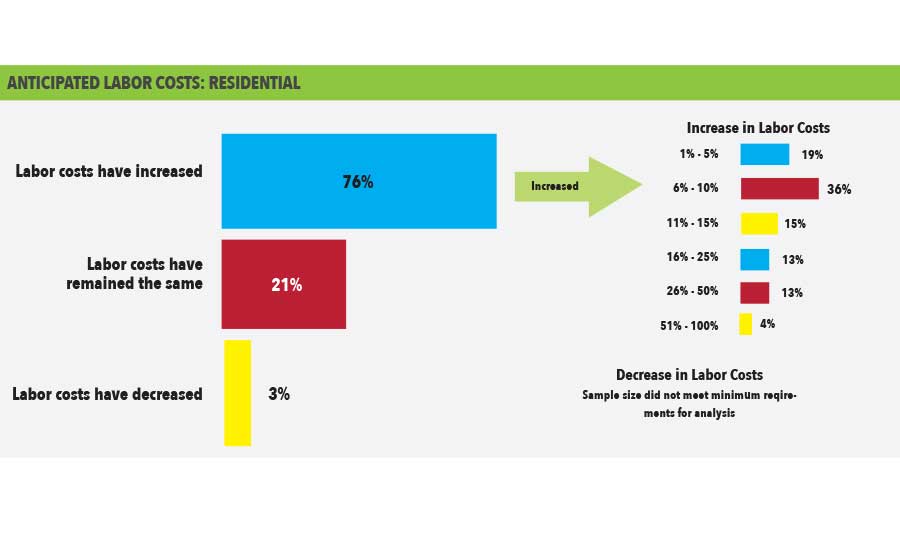
“Training needs to be tailored to individual workers and with this next generation, that’s what hopefully will help attract more people to the industry.” DuCharme said. “We’ve also really got to break the mold of where we train people once and then they’re good. Training, especially to a mastery level, is a continuous process.”
Carlisle is actively working to address the situation with a new $15 million training facility built at its headquarters. The building opened in January and houses meeting rooms with state-of-the-art technology, a theater-style space for educational sessions and presentations, and ample room for product demonstrations and hands-on training.
DuCharme said Carlisle will use the facility in partnership with the National Roofing Contractors Association’s national roofing certification program that will launch this year.
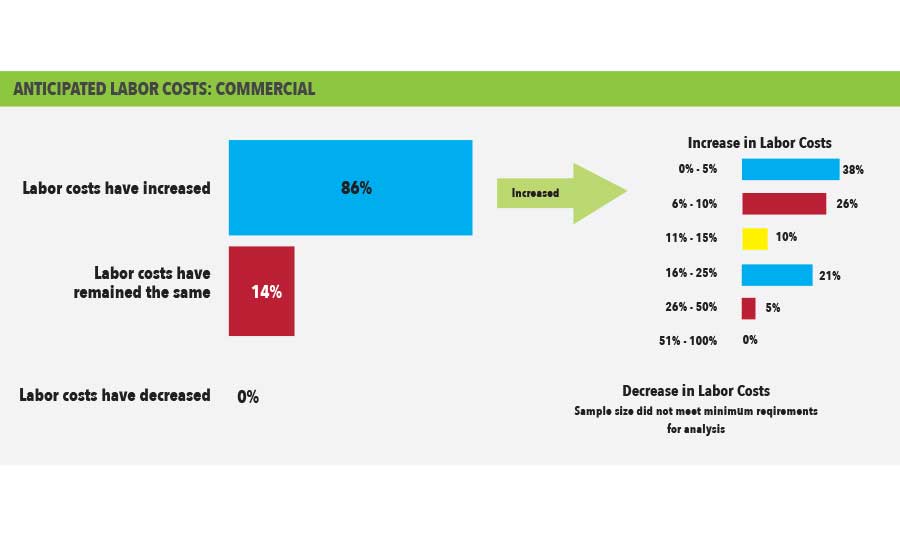
Other manufacturers are also looking forward to seeing how the program can uplift the industry as a whole.
“The national certification program will be a game-changer for our industry,” Lowe said. “According to the Better Business Bureau’s 2016 Complaint and Inquiry Statistics, roofing contractors rank first for number of inquiries and 22nd for complaints, which leads to a high level of mistrust. Roof replacement is a critical investment for homeowners, so it’s natural to have questions about the expertise of their contractor.”
The Future of the Roofing Industry
While 2017 was a time for roofers to feel optimistic and hopeful about deregulation, they still took a wait-and-see approach to evaluate how the business climate will improve. In 2018, there’s no waiting any longer. Many are looking forward to 2018 as a year to take action and seize the opportunity new economic influencers like deregulation and tax reform bring.
“Absolutely. We have experienced a total sales increase of 755 percent since 2014,” said Anthony George, vice president of Delta Exteriors, LLC, of St. Louis. “We opened two offices in 2017 that enabled us to serve two new states. Everyone at Delta is excited as we continue to grow our business and promote leaders.”
Trent Cotney, of Cotney Construction Law, urged roofing contractors to be mindful of lessons from the not-to-distant past as they look forward to planning their goals for 2018 and beyond.
“I would caution roofers to remember the past,” he said. “We are in the peak of a heavy construction cycle nationwide. No one can find skilled labor and roofers are expanding rapidly to try and meet demand. Less than 10 years ago, the industry faced one of the worst periods in its history (2008-09). Instead of creating and adding on enormous overhead to meet demand, roofers should always look to new technology, efficiency and streamlining internal procedures to help eliminate the “fat” that hurt so many roofers during the rough times.”
With the Trump administration’s stance on regulation enforcement now clearer, and its promising legislative achievement in terms of tax reform now behind it, several industry experts said the next political hurdle with potential long-term effects for the roofing industry will be immigration reform.
“With the lack of skilled labor already an issue for roofing contractors, the need to address and deal with immigration issues was at the forefront of almost every roofers’ mind in 2017,” Cotney said. “In 2018, immigration will continue to be an issue that the industry needs to watch. We need to make sure that we’re part of the solution by advocating construction-friendly immigration reform.”
As this year’s study and comments from industry leaders suggest, the roofing industry as a whole continues on an upswing. While that in of itself is promising for contractors eying the bottom line, what makes this particular time in roofing different than business booms of the past is that the industry, through bold leadership and companies committed to its long-term success, appears poised to address major challenges in technology, workforce, regulatory climate and other key factors that will keep it vibrant for years to come.









Report Abusive Comment